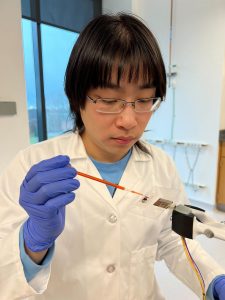Wang lab's collaborative research of multistable soft structures steer flows and choreograph droplets in work published in Device

(Sydney Herdle/UConn Photo)
Materials Science and Engineering Department professor and UConn IMS resident faculty member, Xueju "Sophie" Wang's group has unveiled a simple but powerful way to control liquids: magnetically reconfigurable, multistable ribbons that switch shape on command and then hold that shape without any power. The study, Magnetically Reconfigurable Multistable Ribbon Arrays for Liquid Manipulation, appears in the journal Device. The work is in collaboration with Halim Kusumaatmaja's group at University of Edinburgh, UK and Teng Zhang's group at Syracuse University.
Zizheng Wang, a Ph.D. student under Wang's advisement, is first author for the publication and was the first-place winner of the 2022 Graduate Elevator Pitch Competition. Gabriel Alkuino, a Ph.D. student in Zhang's group at Syracuse, and Samuel J. Avis, a former Ph.D. student in Kusumaatmaja's group at Edinburgh, conducted theoretical and numerical analysis of the devices and provided rational guidelines of experimental designs.
At the heart of the work are thin ribbons made from magnetic polydimethylsiloxane (PDMS)-a soft silicone embedded with magnetic particles-shaped by compressive buckling into three distinct, stable forms. With brief magnetic actuation, each ribbon can transition among these three buckled states and then retain its state without a continuous external field, providing a kind of "mechanical memory" in soft matter.

The researchers first demonstrated a switchable fluid junction inside a two‑dimensional microfluidic channel. By toggling a ribbon's state, the device could redirect liquid to different outlet paths on demand, acting like a valve that is both reconfigurable and energy‑frugal. Because the structure remains in its chosen shape after the field is removed, the flow configuration persists without ongoing input-an advantage for portable or battery‑powered systems.
Building on that concept, the team designed dynamic surface textures by arranging ribbons into addressable arrays. Changing the state of individual ribbons altered the surface's critical angles-the threshold conditions that determine whether a droplet pins in place or is released. In a 2×3 ribbon array testbed, the authors showed that selectively tuning each ribbon's state enables complex droplet manipulations, such as holding, releasing, and routing droplets along programmed paths. This fine‑grained control hints at "pixel‑level" liquid handling for future lab‑on‑a‑chip platforms.
To underpin the experiments, the group performed meso‑scale simulations using coupled electrocapillary models, providing a theoretical framework to guide more sophisticated device layouts and operating modes. These models help map how surface topology and interfacial forces interact (key to designing larger arrays and predicting droplet behavior under different configurations).
Soft, reconfigurable elements that store their state without power could simplify the control architecture of microfluidic systems. Instead of relying on complex networks of pumps, valves, and continuous fields, arrays of multistable ribbons can encode routing instructions directly in their shapes.






